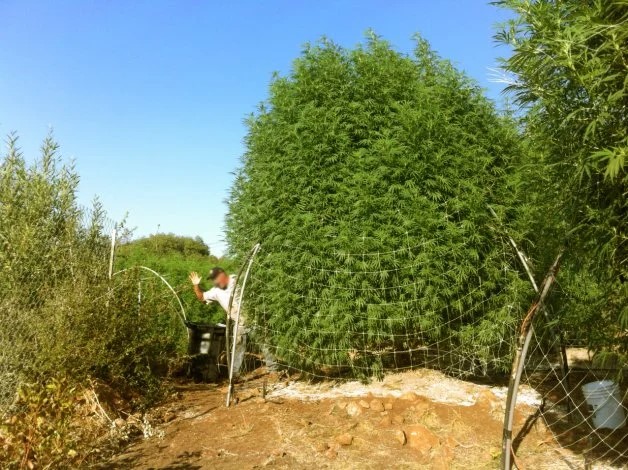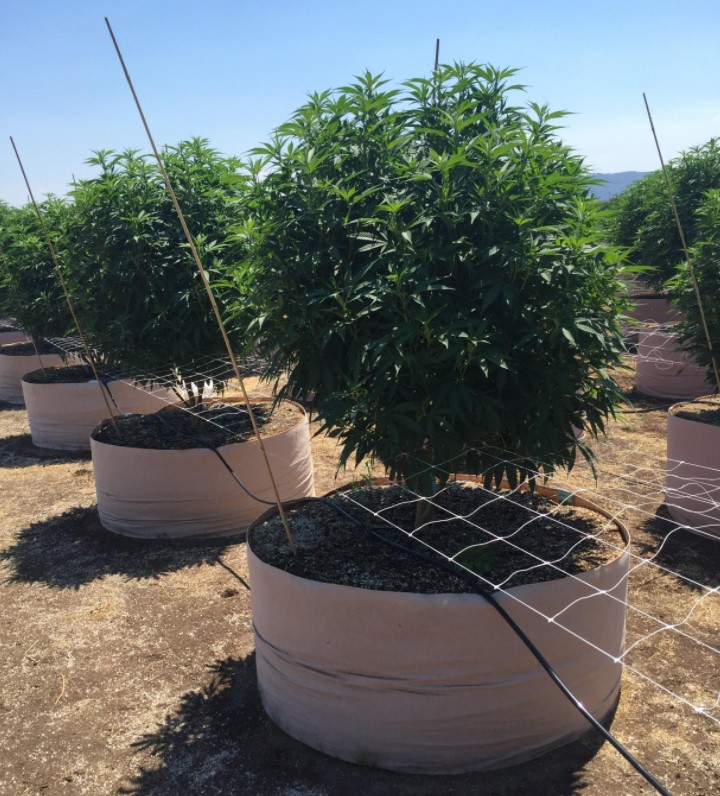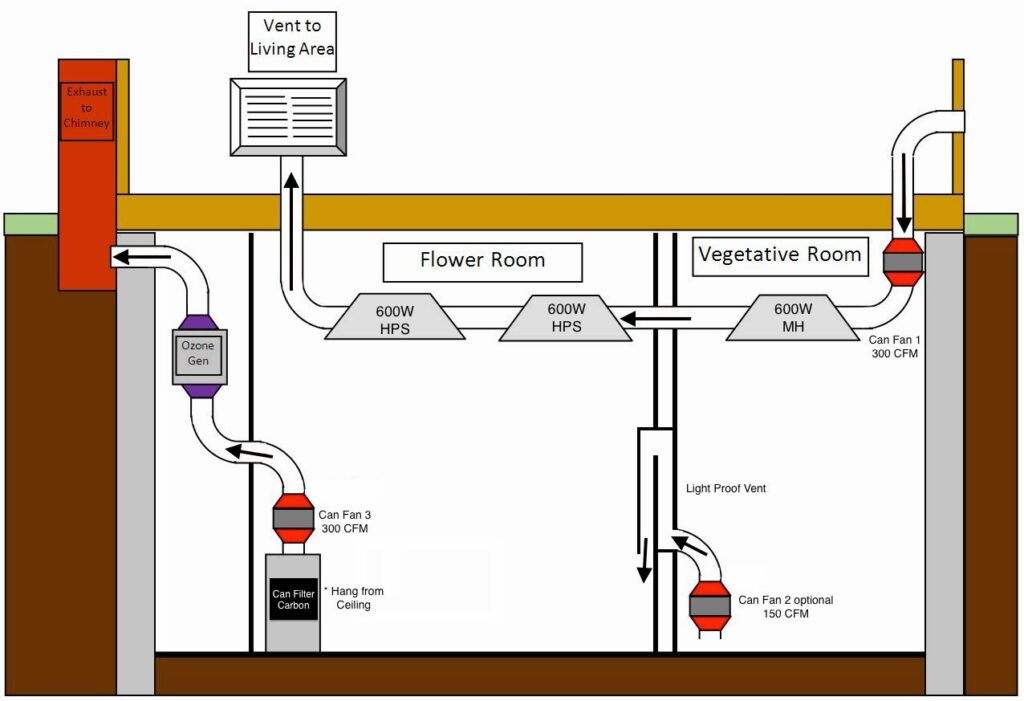As cannabis cultivation becomes increasingly popular, growers are constantly looking for ways to push the limits and grow the biggest, most impressive plants possible. Whether you’re a seasoned cannabis cultivator or just starting out, the prospect of growing giant cannabis plants is undoubtedly exciting. But, how exactly can you achieve this feat? In this article, we’ll explore the various factors that contribute to the growth and size of cannabis plants, as well as tips and techniques you can use to maximize your yield and grow giant cannabis plants. So, let’s dive in!
How big do cannabis plants get
Cannabis plants can grow to a wide range of sizes, depending on various factors such as strain, growing conditions, and genetics. Generally, cannabis plants can grow anywhere from a few inches tall to over 20 feet tall in some cases.
When it comes to indoor cultivation, most growers aim to keep their plants between 3 and 6 feet tall. This is because indoor growing spaces often have height limitations, and taller plants can be difficult to manage and yield less than shorter ones.
Outdoor-grown cannabis plants, on the other hand, can grow much larger than their indoor counterparts. In ideal growing conditions with ample sunlight, nutrients, and water, outdoor cannabis plants can grow to be towering bushes, sometimes exceeding 10 feet in height.
It’s important to note that the size of a cannabis plant doesn’t necessarily equate to its quality or yield. In fact, some of the most potent and high-yielding cannabis strains can be relatively small in stature, while other larger plants may produce lower-quality buds. Nonetheless, if you’re looking to grow giant cannabis plants, there are certain techniques and practices you can follow to increase your chances of success.
10 Tips on Growing Giant Cannabis
If you’re interested in growing giant cannabis plants, there are several key tips and techniques that can help you achieve your goal. From selecting the right strain to providing optimal growing conditions, every step in the process can make a difference in the size and yield of your plants. In this section, we’ll cover some of the most important tips for growing giant cannabis, so you can maximize your chances of success and produce impressive results. So, let’s get started!
1. Pick the Right Strain
When it comes to growing giant cannabis plants, choosing the right strain can make a huge difference in the size and yield of your harvest. Some strains are naturally more vigorous and grow taller than others, while others produce denser and heavier buds. Sativa-dominant strains are generally a good choice for growers looking to produce tall plants, as they tend to have longer internodal spacing, which allows for more branching and can result in taller plants overall. Some popular strains that are known for their tall stature include Critical Mass, Granddaddy Purple, and Blue Dream.
It’s also important to consider other factors beyond plant height when selecting a strain. For example, you may want to choose a strain that is well-suited to your climate or growing environment, as some strains may require specific conditions to thrive. Additionally, you may want to consider the strain’s potency, aroma, and flavor, as these factors can impact your overall enjoyment of the harvest.
When selecting seeds or clones, be sure to do your research and choose a reputable source that offers high-quality genetics. Look for strains that have a proven track record of producing large, healthy plants, and pay attention to factors such as seedling vigor, disease resistance, and overall growth rate. By selecting the right strain, you can set yourself up for success and maximize your chances of growing giant cannabis plants
2. Give the Plant Enough Space
One of the most important factors in growing giant cannabis plants is providing them with enough space to grow. When plants are crowded together, they can become stressed and compete for resources, which can stunt their growth and lead to smaller yields.
The amount of space that each plant needs will depend on a variety of factors, including the strain, the size of the pot, and the growing conditions. As a general rule, you should aim to provide each plant with at least 1-2 square feet of space, or even more if you’re growing a particularly large strain.
When it comes to indoor growing, you’ll need to carefully plan your grow space to ensure that each plant has enough room to spread out. Consider using techniques such as SCROG (screen of green) or LST (low-stress training) to help keep the plant’s canopy even and spread out, which can help maximize the use of space and ensure that each bud receives ample light.
For outdoor growing, you’ll need to make sure that plants are spaced out enough to receive plenty of sunlight and air circulation. In general, you’ll want to space plants at least 3-4 feet apart, depending on the strain and the growing conditions. Be sure to also consider factors such as wind exposure, soil quality, and drainage when selecting your outdoor grow site.
Ultimately, providing your plants with enough space to grow is key to producing giant cannabis plants with big yields. By giving each plant enough room to spread out and thrive, you can help ensure that they reach their full potential and produce the biggest and best buds possible.
3. Bigger Pot = Bigger Plant
The size of the container that you choose to grow your cannabis plant in can have a big impact on its ultimate size and yield. Generally speaking, a larger pot will allow the plant’s root system to grow more extensively, which can lead to a larger plant overall. Conversely, a smaller pot will restrict root growth and can lead to stunted growth and smaller yields.
When selecting a pot for your cannabis plant, it’s important to choose one that is appropriate for the size of the plant and the growing conditions. In general, you should aim to choose a pot that is at least 5 gallons for indoor growing, and even larger for outdoor growing.
It’s also important to consider the type of pot that you choose. Fabric pots, for example, are becoming increasingly popular among cannabis growers due to their ability to promote healthy root growth and improve overall plant health. These pots are made from breathable fabric that allows air to circulate around the root zone, which can help prevent issues such as root rot and nutrient lockout.
When transplanting your cannabis plant into a larger pot, be sure to do so carefully and avoid damaging the roots. You may also want to consider adding additional soil and nutrients to help support the plant’s growth and development.
By choosing a larger pot and providing your plant with ample room to grow, you can help ensure that it reaches its full potential and produces big, healthy buds. Just be sure to choose the right pot size and type for your specific growing conditions to maximize your chances of success.
4. Pick a Quality Soil
Choosing the right soil is crucial to the success of your cannabis grow. The soil you use should be rich in organic matter and provide the right balance of nutrients for your plants.
One popular option for cannabis growers is super soil, which is a pre-made organic soil blend that is specifically formulated for cannabis cultivation. Super soil typically contains a variety of organic materials, such as compost, worm castings, bat guano, and bone meal, as well as essential nutrients like nitrogen, phosphorus, and potassium.
Super soil is designed to provide all of the nutrients your plants need throughout their entire lifecycle, without the need for additional fertilizers or nutrients. This can make it a convenient and cost-effective option for growers who want to simplify their growing process.
If you choose to use regular soil instead of super soil, look for a high-quality potting mix that has been specifically formulated for cannabis cultivation. The soil should contain a blend of organic materials, such as compost, worm castings, and peat moss, as well as essential nutrients.
It’s also important to choose a soil that provides good drainage and aeration to the roots. Soil that is too compacted or dense can prevent oxygen and water from reaching the roots, which can lead to stunted growth and other issues. Look for a soil that contains perlite or vermiculite to help improve drainage and aeration.
In addition to selecting the right soil, it’s important to ensure that the pH levels are appropriate for cannabis cultivation. The ideal pH range for soil-grown cannabis is between 6.0 and 7.0. You can test the pH levels of your soil using a soil pH meter or test kit, and adjust them as necessary using pH up or pH down solutions.
When planting your cannabis plants in soil, be sure to provide enough space for the roots to grow and avoid overwatering, which can lead to root rot. You may also want to consider adding additional nutrients, such as organic fertilizers, to help support the growth and development of your plants.
By choosing a high-quality soil that provides the right nutrients and growing conditions, you can help ensure that your cannabis plants reach their full potential and produce big, healthy buds.
5. Give Plenty of Light
Light is one of the most important factors in cannabis cultivation, and providing your plants with the right amount and type of light is essential for maximizing growth and yield. Depending on whether you are growing your cannabis plants indoors or outdoors, the type of lighting you choose will vary.
Indoor lighting options include high-intensity discharge (HID) lights and light-emitting diode (LED) lights. HID lights are a popular choice among indoor growers because they provide a high amount of light intensity and are relatively affordable. However, they also produce a lot of heat and can be less energy-efficient than LED lights. LED lights, on the other hand, are a more energy-efficient and low-heat solution, making them ideal for indoor growers who want to keep their energy costs low.
When it comes to outdoor lighting, the sun is the primary source of light. However, depending on your location and the time of year, you may need to supplement with artificial lighting to ensure your plants are getting enough light. Outdoor growers may use supplemental lighting options such as LED lights or even high-pressure sodium (HPS) lights to supplement natural sunlight and promote optimal growth.
Regardless of whether you are using indoor or outdoor lighting, it’s important to position your lights at the correct distance from your plants. A good rule of thumb for high-intensity LED lights during the flowering stage is to keep them around 12 inches above the plant canopy to ensure optimal light penetration without burning the plants.
In addition to selecting the right type of lighting, it’s important to provide your cannabis plants with the right amount of light. During the vegetative stage, cannabis plants require between 16 and 18 hours of light per day. This helps promote vigorous vegetative growth and sets the stage for a healthy flowering stage. During the flowering stage, cannabis plants require between 12 and 14 hours of light per day. This helps trigger the flowering process and encourages the development of large, resinous buds.
Providing your cannabis plants with plenty of light is one of the most important steps you can take to help them grow into large, healthy plants with big, resinous buds. By selecting the right type of lighting and ensuring that your plants receive the right amount of light, you can help maximize your yield and produce high-quality cannabis.
6. Extend the Vegetative Stage
Extending the vegetative stage of your cannabis plants can help them grow larger and produce a higher yield. During the vegetative stage, your plants will focus on developing a strong root system and building a solid foundation for future growth. By extending this stage, you give your plants more time to develop and grow, which can result in larger and more robust plants.
To extend the vegetative stage, simply continue to provide your plants with a 16-18 hour light cycle each day. You can continue this light cycle for as long as you want, but most growers extend the vegetative stage for 4-6 weeks to allow their plants to grow to a larger size. During this time, it’s important to keep your plants well-fed and properly watered, as they will require more nutrients and water as they grow larger.
While extending the vegetative stage can be beneficial for increasing the size and yield of your cannabis plants, it’s important to keep in mind that this can also increase the overall time it takes for your plants to reach maturity. If you’re growing in a limited space or have a specific harvest date in mind, you’ll need to factor in the additional time needed for an extended vegetative stage.
7. Provide Proper Nutrients
Providing your cannabis plants with the proper nutrients at each stage of growth is essential for growing healthy and robust plants. While quality soil can provide a good base of nutrients, you will also need to supplement with additional nutrients during the different stages of growth.
Seedling Stage: During the seedling stage, your cannabis plants will require a lower level of nutrients than during the vegetative and flowering stages. Use a balanced, mild nutrient solution with a low concentration of nitrogen to avoid burning the young plants. Also, be careful not to overwater, as seedlings have delicate root systems and can easily become waterlogged.
Vegetative Stage: During the vegetative stage, your plants will require more nitrogen to support their growth. A higher nitrogen fertilizer will help promote leafy growth and prepare the plant for the flowering stage. However, you should also provide a balanced nutrient solution to ensure that the plants receive all of the essential nutrients needed for optimal growth.
Flowering Stage: During the flowering stage, your cannabis plants will require less nitrogen and more phosphorus and potassium to support flower development. A bloom-specific nutrient solution with a higher concentration of phosphorus and potassium is recommended during this stage.
It’s important to note that nutrient requirements can vary depending on the strain of cannabis you’re growing, so it’s a good idea to research the specific needs of the strain you’re working with.
When it comes to growing giant cannabis plants, it’s essential to provide adequate nutrients to support their growth. Overfeeding or underfeeding can result in stunted growth, nutrient deficiencies, or nutrient burn. Be sure to follow the recommended nutrient schedule for your specific plant and strain, and adjust as needed based on your plant’s response.
Also, keep in mind that using high-quality soil, such as super soil, can provide a good base of nutrients for your plants, reducing the need for additional fertilizers. Regular soil testing can also help you determine if your plants are receiving the right balance of nutrients.
8. Train and Stake Your Plant
Training and staking your cannabis plants is essential for growing giant plants. It helps promote more extensive growth, prevents breakage and supports the weight of the buds as they develop.
One of the most popular training techniques used to grow giant cannabis plants is Low-Stress Training (LST). LST involves bending and tying down the main stem and branches to encourage lateral growth and create an even canopy. This technique also helps to increase light penetration, which promotes more robust bud development.
Another popular technique is the Screen of Green (SCROG) method, which involves using a screen or net to create a horizontal plane above the plants. The plants are then trained to grow through the net, creating a flat canopy that is more efficient at utilizing light. This technique can result in higher yields and more consistent growth.
Other training techniques include topping, super cropping, and pruning. Topping involves removing the top of the plant, which encourages lateral growth and creates a bushier plant. Super cropping involves gently bending and squeezing the stem to create stress, which stimulates lateral growth. Pruning involves removing leaves and branches to improve airflow and light penetration.
When it comes to staking your cannabis plants, there are various methods you can use, including using bamboo stakes or trellis netting. Staking helps support the weight of the branches and buds, preventing breakage and allowing the plant to direct more energy towards bud development.
It’s important to note that while training and staking can help promote larger plants and higher yields, it’s essential not to overdo it. Too much stress can harm the plant and reduce yields.
In summary, training and staking are essential techniques for growing giant cannabis plants. LST and SCROG are popular training methods that can increase light penetration and promote more extensive growth, while staking helps support the weight of the plant and prevent breakage. Experiment with different techniques to find what works best for your specific strain and growing conditions.
9. Choose Seeds of Giant Cannabis Strains:
When it comes to growing giant cannabis, choosing the right strain is crucial. Some strains are genetically predisposed to grow larger than others. Here are four strains that are known for producing giant buds:
- Grandaddy Purple – This Indica-dominant strain is famous for its deep purple color and potent effects. It can produce large yields of dense, resinous buds when grown correctly.
- Critical Mass – This hybrid strain is known for its high yields and massive buds. It is a favorite among commercial growers due to its high resin production and ease of growth.
- Blue Dream – This Sativa-dominant hybrid is famous for its soaring, euphoric high, and massive yields. It can produce large, dense buds that are coated in trichomes.
- Gorilla Glue #4 – This potent hybrid strain is famous for its high THC content and sticky resin production. It can produce massive yields of dense, resinous buds that are ideal for making extracts.
Other important tips for growing giant cannabis include giving the plant enough space, using a large pot, choosing a quality growing medium, providing plenty of light, and extending the vegetative stage. Additionally, training and staking your plants can help to maximize yields, and providing the right nutrients is essential for healthy growth. With these tips in mind, you can grow giant cannabis that is sure to impress.
10. Monitor and Control Environmental Factors, and Proper Watering Techniques –
Growing giant cannabis plants requires careful attention to environmental factors and proper watering techniques. Here are some key things to keep in mind:
- Temperature – Cannabis plants thrive in temperatures between 68-77°F (20-25°C) during the day and 58-70°F (14-21°C) at night. High temperatures can cause plants to wilt, while low temperatures can slow growth.
- Humidity – Cannabis plants prefer a relative humidity (RH) of 40-60% during the vegetative stage and 40-50% during the flowering stage. High humidity can lead to mold and mildew, while low humidity can cause dehydration.
- Airflow – Proper airflow is essential for healthy cannabis plants. Use fans to circulate air and prevent stagnant pockets of air that can lead to mold.
- Watering – Overwatering or underwatering can harm cannabis plants. Be careful not to water too frequently or too heavily, as this can lead to root rot.
Employ the Dryback technique:
The idea behind dryback is to allow the soil to dry out slightly between waterings, which can encourage the roots to grow deeper and stronger.
To use the dryback technique, you would water your plants thoroughly, then wait until the top inch or so of soil is dry before watering again. This can help to prevent overwatering and reduce the risk of root rot, which can be a problem for cannabis plants.
However, it’s important to note that the dryback technique isn’t suitable for all growing situations. Some strains of cannabis are more sensitive to changes in soil moisture and may not respond well to dryback. Additionally, if you live in a hot, dry climate, or if you’re growing in a small pot, you may need to water more frequently to prevent the plants from becoming dehydrated.
Ultimately, the best way to determine when to water your cannabis plants is to monitor the soil moisture and adjust your watering schedule as needed.





